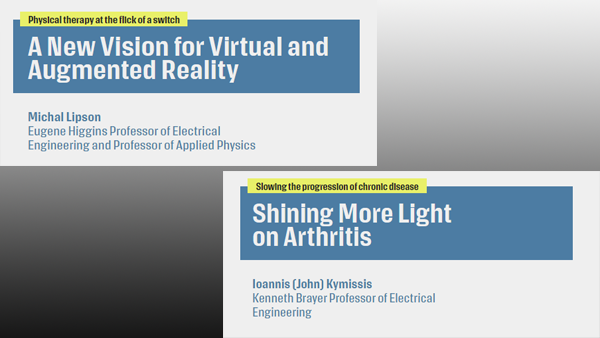Wearables that Could Instantly Improve Your Life - Or Save It

As we age, our bodies not only lose function but also both fall prey to more chronic conditions and often see increased severity in existing ones. But with a little ingenious engineering, better health could be as simple as adding a few items to our wardrobes.
For years, virtual reality (VR) and augmented reality (AR) have been on the cusp of revolutionizing how we engage with our environments. When it comes to everyday quality of life for those struggling with decreased function, the possibilities are particularly profound—from virtually delivering physical therapy or improving cognition to overlaying step-by-step navigation or even correcting vision. Little of that promise can be fully realized, however, until the hardware gets a dramatic upgrade. Today’s headsets are often too heavy, big, and power hungry to practically offer these transformative experiences on a wide scale. That’s why Michal Lipson and her team are developing the fundamental technology needed to sharply reduce their size, weight, and power consumption.
The devil is in the display. Most VR and AR units rely on a suite of multiple components to project their images, rendering the whole device unwieldy and energy-intensive. In contrast, Lipson, along with her PhD student Min Chul Shin and colleagues, integrated their chip-based, low-power, image-beam-steering platforms into one sleek package.
Lipson’s group achieved this by “recycling” their light; by repeatedly feeding it back through the same phase shifter, they reduced the total power consumption dramatically. At the same time, they leapt over another technical hurdle: all the colors of the rainbow are not created equal. Blue light has the smallest wavelength in the visible spectrum and scatters more readily because it travels as shorter, smaller waves. To correct for that, the team precisely placed their emitters in a random configuration to converge in a single high-resolution beam.
These advances have brought them tantalizingly close to their ultimate goal, an ultra-high-resolution VR/AR headset no bigger than an ordinary pair of glasses. But even cooler, their tiny but mighty laser engine could give birth to a host of game-changing technologies. Researchers see their beam-steering system one day driving the lidar used by autonomous vehicles to scan the landscape, a quantum computing system capable of manipulating individual ions, and microscopic lasers able to pinpoint specific neurons inside the brain.
Lupus is a devastating disease in which a person’s immune system runs amok, attacking healthy tissue throughout the body. Roughly 270,000 Americans suffer from lupus, which commonly results in arthritis in the finger joints over time, a phenomenon that’s been difficult to analyze in arthritis patients due in part to the imprecise, costly, and time-consuming nature of even state-of-the-art imaging systems. John Kymissis and his colleagues are developing flexible electronics that can wrap around joints and assess arthritis in an accurate, inexpensive, and easy-to-use way.
The device consists of two flexible plastic bands. One holds multiple light sources and detectors. The other possesses the electronics to control the device and receive data from the sensing band. Analyzing the way in which light reflects off and shines through cells reveals details about tissues, such as concentrations of hemoglobin, the protein that carries oxygen in the blood.
The researchers used their device to analyze two lupus patients and two healthy volunteers. They found that after they inflated a cuff that restricted blood flow through veins in the arm, light was absorbed more quickly in the joints in lupus patients than in healthy volunteers. They hypothesize that this is because stiffer blood vessel walls and inflamed areas surround these patients’ joints, both factors that would make it easier for blood to pool and absorb light. Using hemoglobin data to generate 3-D images, they’re gathering more precise details on how arthritis affects fingers.
Kymissis and his team noted that their prototype costs less than $100, a fraction of that of ultrasound and MRI systems. Access to such a simple but powerful device could one day help doctors assess lupus arthritis at every patient’s visit, something that could not only help deliver more tailored care but also serve as a boon for clinical trials where doctors need better tools to evaluate which potential drugs might best treat lupus overall.